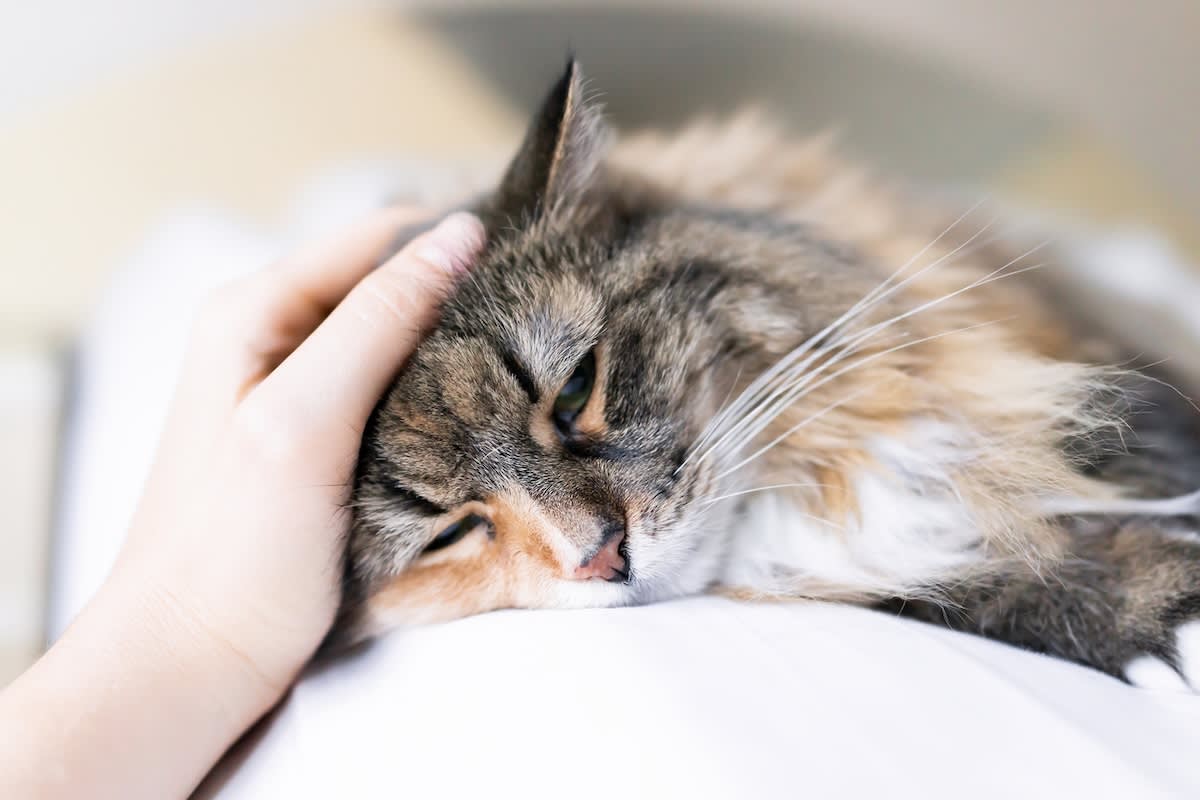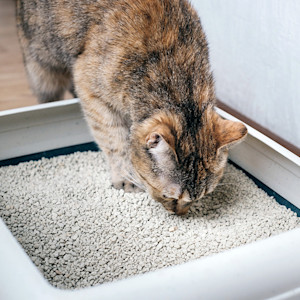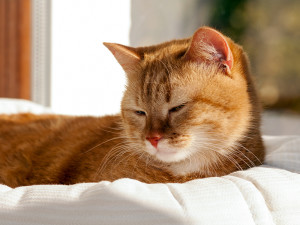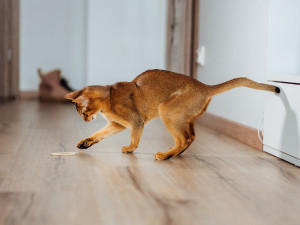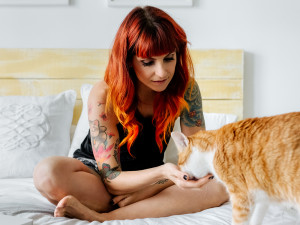This Sadly Common Heart Condition Mainly Affects These Cat Breeds
Complicated name, but a disease cat parents need to know
We never want to think about our pets getting poorly – the thought of them being in pain or suffering is almost too much to bear. But as pet parents, it’s also our job to educate ourselves about the various illness and conditions that they might be encounter in their lives.
Take hypertrophic cardiomyopathy (HCM for short), for instance. Sure, it sounds like something Meredith Gray would bark at an intern before whipping out the defibrillator paddles, but it’s actually the most common heart condition that cats can get with around 15 percent of them developing it during their life (and yes, humans do get it too, but we’re talking about cats here).
So, what should every responsible cat parent know about this condition? And is there anything we can do to prevent it? Read on for all you need to know.
What is hypertrophic cardiomyopathy (HCM) in cats?
Like all mammals, cats have four heart chambers: the left and right atria, which receive blood, and the left and right ventricles, which pump blood out. The left atrium receives oxygen-rich blood from the lungs, and the left ventricle pumps it around the body. The right atrium collects blood returning from the body, and the right ventricle sends it back to the lungs to collect more oxygen.
How much do you spend on your pet per year?
In cats with hypertrophic cardiomyopathy (HCM), the wall of the left ventricle becomes abnormally thickened, leaving less space inside the chamber. This reduces the amount of blood the heart can hold and pump with each beat, causing increased backward pressure in the heart and lungs.
How common is hypertrophic cardiomyopathy in cats?
HCM is the most common type of heart disease in pet cats, affecting around 15 percent of the feline population. This percentage increases with age, and certain breeds are more susceptible. Many cats develop changes in their heart structure without showing any outward signs, but a proportion will go on to develop clinical symptoms.
Causes and risk factors of hypertrophic cardiomyopathy in cats
While HCM can affect cats of any breed, age or gender, it is more frequently seen in males and domestic short-haired cats. Genetic mutations linked to HCM have been identified in certain breeds, including Maine Coons, Ragdolls and Sphynx cats. Other breeds such as Persians, Bengals and British Shorthairs may also have an increased risk.
It’s important to distinguish true HCM from other conditions that can mimic it. Diseases such as hyperthyroidism, high blood pressure and acromegaly can also lead to thickened heart walls but are not classed as true hypertrophic cardiomyopathy, however the clinical outcomes are the same. Obesity can also contribute to the likelihood of a cat developing symptoms.
Symptoms of hypertrophic cardiomyopathy in cats
Many cats with HCM will display no symptoms at all, leading a long and healthy lives (phew!). Unfortunately, some cats develop severe complications, which can be sudden and life-threatening.
Early warning signs
Early detection of HCN is really important, as starting treatment in the early stages can help slow the disease progression. Most cats without symptoms are diagnosed incidentally, for instance when a vet detects a heart murmur or abnormal rhythm during a routine check-up. Some subtle signs you can look out for at home include rapid breathing while they’re resting or asleep, lethargy or reduced activity, weight loss or behavioural changes like hiding or becoming less playful.
Advanced symptoms and complications
As the disease progresses, pressure inside your cat’s heart increases and the left atrium begins to enlarge. This causes pressure to build in the veins of the lungs, leading to fluid leaking into the chest. This is a condition known as pulmonary oedema and is extremely serious. Cats affected in this way will have difficulty breathing, which can become severe. If your cat is breathing with their mouth open or stretching their neck out, they require immediate treatment as this stage can be rapidly fatal.
As blood swirls in the enlarged left atrium, it can begin to clot. These clots may then break off and travel through the bloodstream, obstructing major arteries. The most affected vessel is the aorta that supplies blood to the back legs. If this happens it is a condition known as aortic thromboembolism (ATE). Cats experiencing an ATE often present suddenly with severe pain, dragging their hind limbs and vocalising in distress. Treatment is intensive and may not be successful. Sadly, if this happens, there is also a high likelihood of recurrence.
How vets diagnose hypertrophic cardiomyopathy in cats
If your vet detects a heart murmur or an abnormal rhythm in your kitty, they may recommend further tests. These typically include an ultrasound scan of the heart, known as an echocardiogram, which provides detailed images of the heart’s structure and function.
A chest X-ray may also be performed to check for signs of heart enlargement or fluid in the lungs. An electrocardiogram (ECG) can assess the heart’s electrical activity and rhythm. It’s important to rule out underlying disease that can affect the heart so your vet may also perform blood pressure measurements to rule out high blood pressure and blood tests may be conducted to check for underlying conditions such as hyperthyroidism or kidney disease, which can also affect heart health.
How to treat hypertrophic cardiomyopathy in cats
Some causes of ventricular thickening, such as hyperthyroidism-induced HCM, are reversible with early treatment. However, true (genetic) HCM has no cure.
Treatment revolves around minimising symptoms and tends to involve the following medications.
Pimobendan: this may be prescribed for cats with mild HCM but without symptoms. It helps the heart function more efficiently. However, it’s crucial to confirm (via ultrasound) that there is no obstruction to blood flow before prescribing it.
Diuretics (eg, furosemide): these help remove excess fluid from the lungs by increasing urine output and are usually started in cats who have trouble breathing.
Anti-clotting medication: used to reduce the risk of life-threatening blood clots.
ACE inhibitors: these may be added to reduce fluid retention by encouraging the kidneys to excrete salt and water if a cat has high blood pressure.
As the disease progresses, some cats become resistant to medications. At this stage, quality of life becomes the main concern, and euthanasia may be the kindest option.
Prognosis and life expectancy of a cat with hypertrophic cardiomyopathy
Sadly, there is no cure for genetically inherited hypertrophic cardiomyopathy. However, many cats will never develop symptoms, enjoying long and healthy lives despite having the condition. For those that do show symptoms, the outlook varies significantly. Once clinical signs appear, some cats may decline rapidly and succumb to heart failure or blood clots within six to eighteen months.
However, this timeline is highly variable, and some cats can live for several years with appropriate treatment and monitoring. Breed also plays a major role in prognosis, as certain genetic mutations lead to more aggressive forms of the disease. For example, Ragdoll cats are unfortunately often affected by a particularly severe and fast-progressing form of HCM.
Prevention and management of hypertrophic cardiomyopathy in cats
Preventing HCM is difficult. Even with responsible breeding, it’s not possible to eliminate all genetic risk, as many factors influence disease development.
Early detection and regular veterinary check-ups are essential. For cats diagnosed early, appropriate medication and monitoring may really help to slow the disease progression and improve your kitty‘s quality of life.
Bottom line: hypertrophic cardiomyopathy in cats
HCM is a common and potentially serious heart condition in cats, especially in certain breeds. While many cats may live a full life without ever showing symptoms, others can develop sudden and life-threatening complications. Early detection through routine vet check-ups is key, and if diagnosed, timely treatment can help manage the condition and improve quality of life. Although there is no cure for genetic HCM, understanding the disease and working closely with your vet can make a significant difference to your cat’s well-being and longevity.
Frequently asked questions: hypertrophic cardiomyopathy
Are there genetic causes of hypertrophic cardiomyopathy in cats?
True HCM in cats is genetic in nature, with many genetic mutations contributing to an increased risk of developing the condition. For example, mutations in the MYBPC3 gene have been strongly associated with HCM in Maine Coon and Ragdoll cats. Whilst the presence of a mutation does not guarantee that a cat will develop the disease, it significantly raises the likelihood, making genetic testing an important tool in managing breeding programmes and monitoring at-risk cats.
Are some cats more prone to developing hypertrophic cardiomyopathy?
Whilst all ages and breeds can be affected. Male cats are more likely to develop HCM than females and certain breeds, such as Domestic Short Hairs, Ragdolls, Maine Coons, Persians and British Shorthairs are at an increased risk.
What is the prognosis for cats with hypertrophic cardiomyopathy?
Some cats with HCM will live a long, healthy life without ever developing symptoms, however if symptoms do develop the disease often progresses quickly, with complications such as arterial blood clots or heart failure. These complications often carry a poor prognosis often necessitating euthanasia, though treatment can sometimes provide additional time and comfort.
References
Fuentes, Virginia Luis, et al. ACVIM Consensus Statement Guidelines for the Classification, Diagnosis, and Management of Cardiomyopathies in Cats. Journal of Veterinary Internal Medicineopens in new tab, vol. 34, no. 3, 2020, pp. 1062–1077.
Matos, João N., et al. “Natural History of Hypertrophic Cardiomyopathy in Cats from Rehoming Centers: The CatScan II Study.”opens in new tab Journal of Veterinary Internal Medicine, vol. 36, no. 6, Nov. 2022, pp. 1900–1912. Wiley, doi:10.1111/jvim.16576.
“The Unseen Side of Feline Hypertrophic Cardiomyopathy: Diagnostic and Prognostic Utility of Electrocardiography and Holter Monitoring.opens in new tab” Animals, vol. 14, no. 15, 2024, article 2165. MDPI, doi:10.3390/ani14152165.
“Investigation of Coagulation and Proteomics Profiles in Symptomatic Feline Hypertrophic Cardiomyopathy and Healthy Control Cats.opens in new tab” BMC Veterinary Research, vol. 20, Article 292, 5 July 2024. Springer Nature, doi:10.1186/s12917-024-04170-0.
“Identification of Novel Genetic Variants Associated with Feline Cardiomyopathy Using Targeted Next-Generation Sequencingopens in new tab.” PMC, 2023, PMC11785968.
Kaplan, Joanna L., et al. “Unraveling the Genetics of Feline Hypertrophic Cardiomyopathy: A Multiomics Study of 138 Cats.opens in new tab” G3, vol. 15, no. 9, July 2025, jkab153. PMC, doi:10.1093/g3journal/jkaf153.
“Genetics of Feline Hypertrophic Cardiomyopathy.opens in new tab” PubMed, 2020, PMID 32215921.
“A Feline Orthologue of the Human MYH7 c.5647G>A (p.(Glu1883Lys)) Variant Causes Hypertrophic Cardiomyopathy in a Domestic Shorthair Catopens in new tab.” European Journal of Human Genetics, 2019. doi:10.1038/s41431-019-0431-4.
“Hypertrophic Cardiomyopathy in Man and Cats.opens in new tab” Journal of Veterinary Cardiology, vol. 17, Supplement 1, Dec. 2015, pp. S6–S9. ScienceDirect, doi:10.1016/j.jvc.2015.03.007.
“Clinical-Diagnostic and Therapeutic Advances in Feline Hypertrophic Cardiomyopathy.” PMC, PMC11946439.
